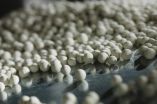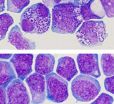(Press-News.org) In many industrialized countries, city skylines are dominated by imposing glass façades and skyscrapers made of concrete and steel. There is a drawback to these magnificent structures, though – they often get very hot in the summer, so they mostly need elaborate and costly air conditioning systems. And these already account for some 14 percent of Germany's annual energy consumption. Experts reckon that total cooling requirements in buildings will triple by 2020.
Cooling and heating using metal organic frameworks
Thermally driven cooling systems are one possible alternative to traditional air conditioning. These systems use the evaporation of fluids such as water at low pressure to remove heat from the environment – an energy-efficient cooling method. Now researchers from the Fraunhofer Institute for Solar Energy Systems ISE in Freiburg are working on innovative sorbents that can store a particularly large amount of water vapor. To develop this material, researchers have turned to metal organic frameworks (MOFs). "The material is highly porous and can adsorb more than 1.4 times its own weight in water," says Dr. Stefan Henniger from Fraunhofer ISE, describing one distinctive property of these sorbents.
MOFs can also be used in thermally driven heat pumps. Whereas electric heat pumps feature an electrical compressor, in these pumps an adsorbent performs the role of a "thermal compressor" while water serves as coolant. The gaseous coolant is adsorbed by the sorbent, thus leaving the gaseous phase. The heat that results from this adsorption into the material's hollow interior is transferred away by a heat exchanger and can be used for heating. For this to function, the sorbent must be applied to the surface of the heat exchanger in such a way that the coolant evaporates continuously until the sorbent is saturated. Once the maximum adsorption capacity is reached, driving heat is used to drive off the stored coolant and liquefy it. The heat of condensation released in the process can also be used for heating.
To capitalize on the full potential of MOFs, it is important not only for water vapor to have easy access to the inner surfaces and pore space of the material but also for heat transfer away from the material to be effective. To aid the process, experts at Fraunhofer ISE have developed a new coating technique, for which they applied for a patent. This technique allows the new sorbents to be applied to equipment such as heat exchangers without obstructing heat and mass transfer. The research is being funded by the German Federal Ministry for Economic Affairs and Energy.
Heat from storage
Industrial facilities, power stations and biogas plants all make use of processes in which heat is essentially a waste product. Currently, hardly any of this heat energy is put to use – something that scientists at the Fraunhofer Institute for Interfacial Engineering and Biotechnology IGB in Stuttgart want to change. The researchers are working on developing and optimizing zeolite thermal storage systems.
Zeolites are crystalline minerals with a porous structure that adsorbs other substances such as water. Their internal surface area can be as much as 1000 square meters per gram. When the zeolite comes into contact with water vapor, it binds water molecules within its pores, releasing heat in the process. Drying out the material is a way to store heat; the energy this takes is released as heat as soon as water vapor is again adsorbed. Experts from Fraunhofer IGB are now developing technology to allow this heat storage technique to be used.
Thermochemical heat storage systems based on a combination of zeolites and water have the potential to amass up to 180 kilowatt hours of energy per cubic meter depending on the charging temperature and the application. To put this into perspective, traditional hot water energy storage systems normally have an energy density of less than 60 kilowatt hours per cubic meter. However, zeolite sorptive thermal storage devices are in this stage of development relatively expensive. "From an economic and technical standpoint, we currently see this technology being implemented in industry," says Mike Blicker, group manager, heat and sorption systems at Fraunhofer IGB.
INFORMATION: END
Sorption energy storage and conversion for cooling and heating
2014-03-18
ELSE PRESS RELEASES FROM THIS DATE:
What factors contribute to sexual assault in the military and what can be done to prevent it?
2014-03-18
New Rochelle, NY, March 18, 2014–Recent high-profile cases have drawn attention to the problem of sexual assault in the U.S. military, the effects on survivors, and the actions and response of military leadership. Issues such as why there is more sexual assault in the military than in the general population, why it is under-reported, and what preventive approaches should the military adopt are explored in a provocative Roundtable Discussion published in the preview issue of Violence and Gender, a new peer-reviewed journal from Mary Ann Liebert, Inc., publishers. The article ...
Major breakthrough in developing new cancer drugs: Capturing leukemic stem cells
2014-03-18
This news release is available in French.
The Institute for Research in Immunology and Cancer (IRIC) at the Université de Montréal (UdeM), in collaboration with the Maisonneuve-Rosemont Hospital's Quebec Leukemia Cell Bank, recently achieved a significant breakthrough thanks to the laboratory growth of leukemic stem cells, which will speed up the development of new cancer drugs.
In a recent study published in Nature Methods, the scientists involved describe how they succeeded in identifying two new chemical compounds that allow to maintain leukemic stem cells ...
Getting rid of bad vibrations
2014-03-18
Whether you're looking at hairy spider legs, the alien-like faces of ants, or the spiky-looking surfaces of pollen – a scanning electron microscope delivers high-resolution images that are rich in detail. But you can't get perfect images unless you protect the microscope from vibration. If someone walking across the room or an elevator going up and down between nearby floors makes the table shake, you're unlikely to get good results. The simplest way to quell vibrations is to put the microscope on a granite base – a stone so heavy that it dampens vibrations occurring at ...
Who's afraid of math? Study finds some genetic factors
2014-03-18
COLUMBUS, Ohio – A new study of math anxiety shows how some people may be at greater risk to fear math not only because of negative experiences, but also because of genetic risks related to both general anxiety and math skills.
The study, which examined how fraternal and identical twins differ on measures of math anxiety, provides a revised view on why some children – and adults – may develop a fear of math that makes it more difficult for them to solve math problems and succeed in school.
"We found that math anxiety taps into genetic predispositions in two ways: people's ...
Suppressing unwanted memories reduces their unconscious influence on behavior
2014-03-18
Researchers part-funded by the Medical Research Council (MRC) have shown that, contrary to what was previously assumed, suppressing unwanted memories reduces their unconscious influences on subsequent behaviour, and have shed light on how this process happens in the brain.
The study, published online in PNAS, challenges the idea that suppressed memories remain fully preserved in the brain's unconscious, allowing them to be inadvertently expressed in someone's behaviour. The results of the study suggest instead that the act of suppressing intrusive memories helps to disrupt ...
Lessons from a meadow
2014-03-18
For almost 40 years, field scientists strapped on cross-country skis, shouldered backpacks with supplies and set out over three miles of snow and rocks to a field station by a meadow high in the Rocky Mountains as soon as the snow began melting. Every other day, they counted each flower they found, identified the plant it belonged to and kept meticulous records of their observations.
Their observations provide the longest-running scientific study of its kind and tell a story of biological change that teaches scientists new lessons about phenology – the timing of biological ...
Supplements not associated with reduced risk of cardiovascular disease in elderly
2014-03-18
Bottom Line: Daily dietary supplements of omega-3 polyunsaturated fatty acids (also found in fish) or lutein and zeaxanthin (nutrients found in green leafy vegetables) were not associated with reduced risk for cardiovascular disease (CVD) in elderly patients with the eye disease age-related macular degeneration.
Author: The writing group for the Age-Related Eye Disease Study 2 (AREDS2) clinical trial.
Background: Diet studies have suggested that increased intake of fish, a source of omega (ω)-3 fatty acids, can reduce rates of cardiac death, death from all other ...
Study finds high utilization of neuroimaging for headaches despite guidelines
2014-03-18
Bottom Line: Neuroimaging for headaches is frequently ordered by physicians during outpatient visits, despite guidelines that recommend against such routine procedures.
Author: Brian C. Callaghan, M.D., M.S., of the University of Michigan Health System, Ann Arbor, and colleagues.
Background: Most headaches are due to benign causes, and multiple guidelines have recommended against routine neuroimaging for headaches.
How the Study Was Conducted: The authors analyzed National Ambulatory Medical Care Survey data for all headache visits for patients 18 years or older ...
The frozen truth about glaciers, climate change and our future
2014-03-18
Lewis Owen has been scraping out icy fragments of history's truth from one of the most glaciated regions on Earth for the past 25 years.
His frequent excursions to Tibet and the Himalayas have led the University of Cincinnati professor of geology to some cold, hard facts.
Owen knows climate change is immortal – fluctuating across millennia, patiently building toward moments when circumstances are ripe for apocalypse. It was true thousands of years ago, when rapid climate change had profound effects on landscapes and the creatures that lived on them. That scenario could ...
Rice study: Simple changes to homework improved student learning
2014-03-18
A new study offers evidence that simple and inexpensive changes to existing courses can help students learn more effectively.
The study from Rice University and Duke University found that making a few changes to homework assignments in an upper-level undergraduate engineering course at Rice led to improved scores on exams. The study appears this week in the journal Educational Psychology Review.
The findings by a team from Rice's Center for Digital Learning and Scholarship and Duke's Department of Psychology and Neuroscience demonstrate how technology and cognitive ...





